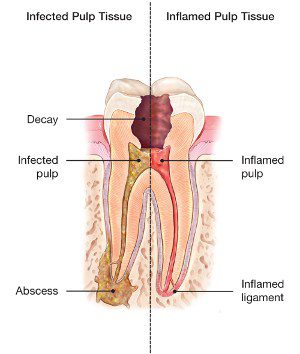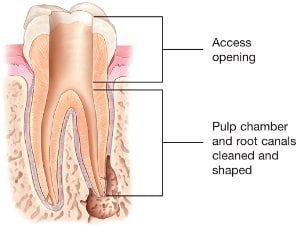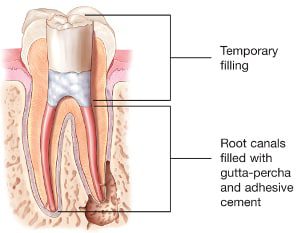Root Canal Treatment
 The first step is to ensure your comfort by administering local anesthetic (“numbing”, or “freezing” the tooth or area). Then a small protective sheet called a “dental dam” is placed over the tooth in order to provide a sterile field thereby preventing bacteria from entering the tooth via saliva. This protective sheet is also used to prevent debris, disinfectants, or instruments from inadvertently going down your throat while the root canal treatment is performed.
The first step is to ensure your comfort by administering local anesthetic (“numbing”, or “freezing” the tooth or area). Then a small protective sheet called a “dental dam” is placed over the tooth in order to provide a sterile field thereby preventing bacteria from entering the tooth via saliva. This protective sheet is also used to prevent debris, disinfectants, or instruments from inadvertently going down your throat while the root canal treatment is performed.
 Next, an opening is made through the crown of the tooth in order to gain access to the inflamed or infected pulp. This step also includes removing decay and sometimes old fillings. Very fine instruments, along with disinfectants are used to clean the root canal system. This process also provides shaping of the canal spaces to receive a root canal filling, which consists of a biocompatible material called gutta-percha that is placed permanently into the canals with cement.
Next, an opening is made through the crown of the tooth in order to gain access to the inflamed or infected pulp. This step also includes removing decay and sometimes old fillings. Very fine instruments, along with disinfectants are used to clean the root canal system. This process also provides shaping of the canal spaces to receive a root canal filling, which consists of a biocompatible material called gutta-percha that is placed permanently into the canals with cement.
 Finally, a temporary filling is placed to close the opening in your tooth. Your general dentist will remove this temporary filling at the time the tooth is restored, usually with a crown. Following root canal treatment your tooth is susceptible to fracturing, or to infection due to loss of the temporary filling. Therefore, it is imperative that you return to your general dentist in a timely manner in order to restore the tooth to its full functionality.
Finally, a temporary filling is placed to close the opening in your tooth. Your general dentist will remove this temporary filling at the time the tooth is restored, usually with a crown. Following root canal treatment your tooth is susceptible to fracturing, or to infection due to loss of the temporary filling. Therefore, it is imperative that you return to your general dentist in a timely manner in order to restore the tooth to its full functionality.

Root Canal Treatment, Step by Step
This informative video will walk you step-by-step through the procedure and explain how endodontists, the root canal specialists, can save your teeth.
Myths About Root Canals
The thought of a root canal may make you fearful or uneasy if you aren’t familiar with the procedure. There are common misconceptions that endodontic treatments such as root canals, cause pain and/or illness and should be avoided at all costs. The exact opposite is true. The pain, inconvenience and cost of avoiding endodontic treatment in favor of tooth extraction or a wait-and-see approach can be easily avoided. The longer you postpone treatment the more you risk the chance to save your tooth. Take the time to read the information on our website to find out what endodontists do to save teeth with minimal time and discomfort. Then address any remaining concerns or questions with your dentist or endodontist.
Put your mind at ease as we dispel three common myths about root canals:
Myth 1: Root canal treatment is painful.
Decades ago that may have been the case, but with modern technology and anesthetics you won’t experience any more pain than if you went to have a cavity filled. The pain from a severe toothache, often caused by damaged tissues in the tooth, can be easily remedied when an endodontist removes the damaged tissue through root canal treatment. In addition, endodontists are experts in pain management, and most cases can be treated quickly and comfortably.
Myth 2: Root canal treatment causes illness.
Information you may find on the Internet or elsewhere, claiming that if you receive a root canal treatment you’re more likely to become ill or contract a disease in the future simply isn’t true. This false claim was based on long-debunked and poorly designed research conducted nearly a century ago, long before modern medicine understood the causes of many diseases. There is no valid, scientific evidence linking root canal treatment to disease elsewhere in the body.
Myth 3: It’s better to pull a tooth than have root canal treatment.
Saving your natural teeth, if possible, is always the best option. Nothing artificial can replace the look or function of a natural tooth so it’s important to always consider root canal treatment as an option. Endodontic treatment has a high success rate and many root canal-treated teeth last a lifetime. Replacing an extracted tooth with a bridge or implant requires more time in treatment and may result in further procedures to neighboring teeth and supporting tissue.
Root Canal Safety
If you have concerns about the safety of root canal treatment, watch this authoritative and informative video. In it, endodontists explain that claims about root canal treatment causing disease are based on out-dated theories, and help you understand that millions of root canal treatments are completed every year, safely, effectively and comfortably.
